In-Depth Article Review: Evaluating Software Testing Standards
VerifiedAdded on 2023/06/05
|12
|2986
|242
Literature Review
AI Summary
This document presents a comprehensive literature review focusing on software testing standards, particularly dynamic testing. It begins by introducing the concept of software testing standards and delves into a research paper analyzing software component testing strategies advocated by the British Computer Society. The review addresses key questions about the chosen standard, including its name, copyright holder (UK Interim Defence Standard), involved universities (National Physical Laboratory, Durham University), scope, key terms, application results, and relevance to software testing. The review highlights the importance of dynamic testing in ensuring software reliability and meeting customer needs, contrasting it with static analysis. It further discusses commonalities and differences between various existing testing standards, such as RS 5887, MOD 00-55, and ANSI/IEEE standards, emphasizing their relevance to quality assurance and documentation. The paper concludes by underscoring the role of standardization in legally assuring software testing processes and ensuring security and reliability.
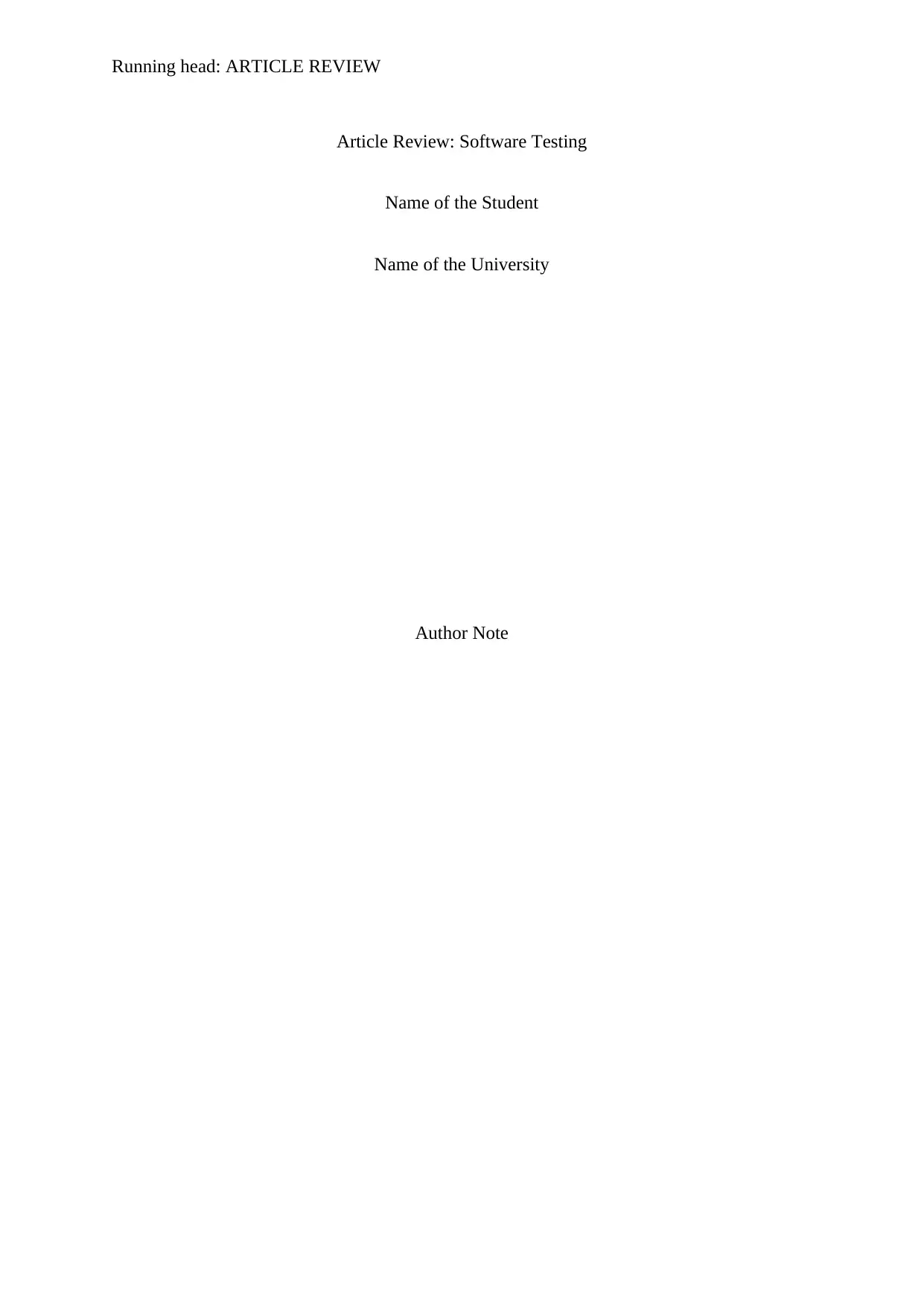
Running head: ARTICLE REVIEW
Article Review: Software Testing
Name of the Student
Name of the University
Author Note
Article Review: Software Testing
Name of the Student
Name of the University
Author Note
Paraphrase This Document
Need a fresh take? Get an instant paraphrase of this document with our AI Paraphraser
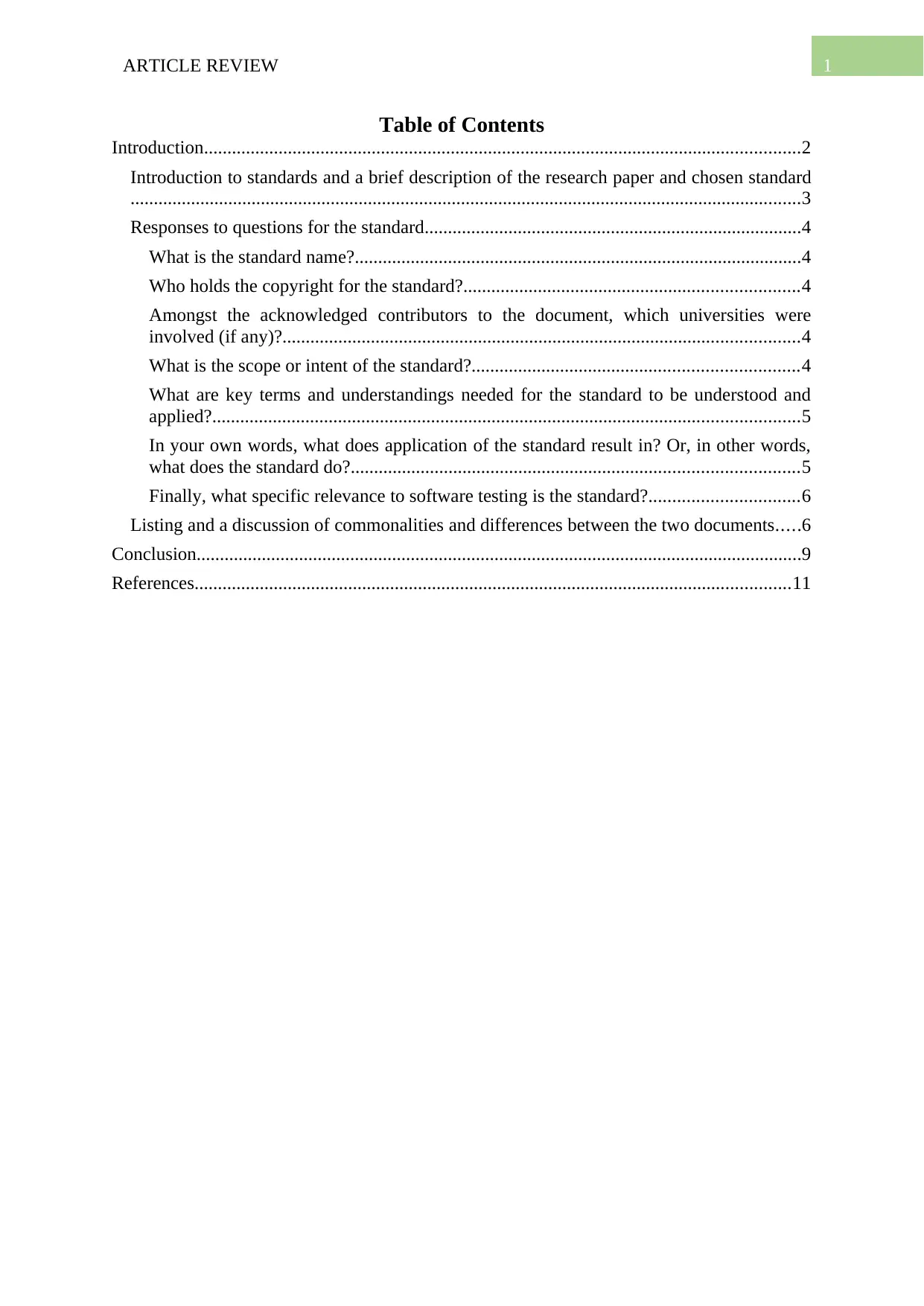
1ARTICLE REVIEW
Table of Contents
Introduction................................................................................................................................2
Introduction to standards and a brief description of the research paper and chosen standard
................................................................................................................................................3
Responses to questions for the standard.................................................................................4
What is the standard name?................................................................................................4
Who holds the copyright for the standard?........................................................................4
Amongst the acknowledged contributors to the document, which universities were
involved (if any)?...............................................................................................................4
What is the scope or intent of the standard?......................................................................4
What are key terms and understandings needed for the standard to be understood and
applied?..............................................................................................................................5
In your own words, what does application of the standard result in? Or, in other words,
what does the standard do?................................................................................................5
Finally, what specific relevance to software testing is the standard?................................6
Listing and a discussion of commonalities and differences between the two documents.....6
Conclusion..................................................................................................................................9
References................................................................................................................................11
Table of Contents
Introduction................................................................................................................................2
Introduction to standards and a brief description of the research paper and chosen standard
................................................................................................................................................3
Responses to questions for the standard.................................................................................4
What is the standard name?................................................................................................4
Who holds the copyright for the standard?........................................................................4
Amongst the acknowledged contributors to the document, which universities were
involved (if any)?...............................................................................................................4
What is the scope or intent of the standard?......................................................................4
What are key terms and understandings needed for the standard to be understood and
applied?..............................................................................................................................5
In your own words, what does application of the standard result in? Or, in other words,
what does the standard do?................................................................................................5
Finally, what specific relevance to software testing is the standard?................................6
Listing and a discussion of commonalities and differences between the two documents.....6
Conclusion..................................................................................................................................9
References................................................................................................................................11
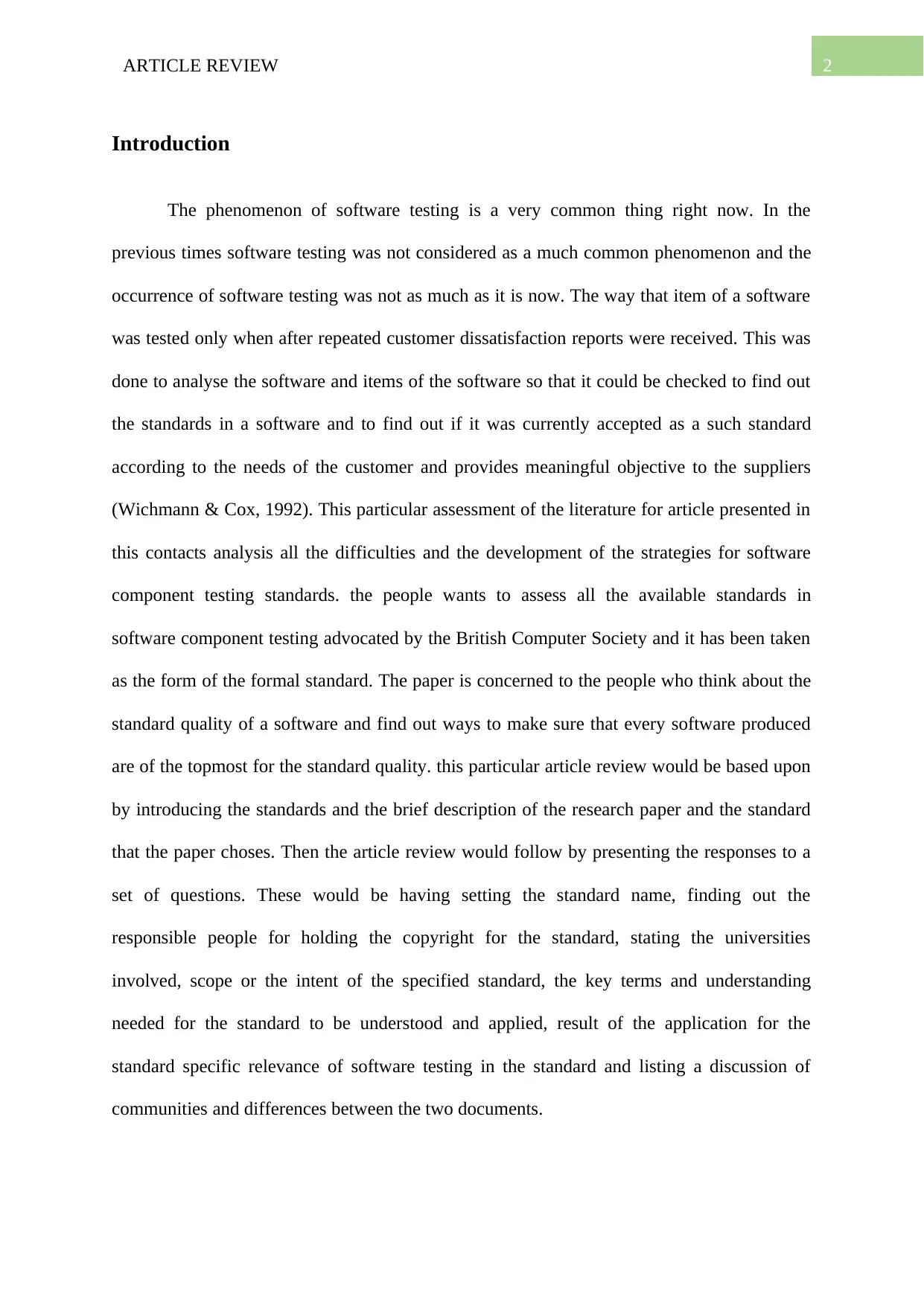
2ARTICLE REVIEW
Introduction
The phenomenon of software testing is a very common thing right now. In the
previous times software testing was not considered as a much common phenomenon and the
occurrence of software testing was not as much as it is now. The way that item of a software
was tested only when after repeated customer dissatisfaction reports were received. This was
done to analyse the software and items of the software so that it could be checked to find out
the standards in a software and to find out if it was currently accepted as a such standard
according to the needs of the customer and provides meaningful objective to the suppliers
(Wichmann & Cox, 1992). This particular assessment of the literature for article presented in
this contacts analysis all the difficulties and the development of the strategies for software
component testing standards. the people wants to assess all the available standards in
software component testing advocated by the British Computer Society and it has been taken
as the form of the formal standard. The paper is concerned to the people who think about the
standard quality of a software and find out ways to make sure that every software produced
are of the topmost for the standard quality. this particular article review would be based upon
by introducing the standards and the brief description of the research paper and the standard
that the paper choses. Then the article review would follow by presenting the responses to a
set of questions. These would be having setting the standard name, finding out the
responsible people for holding the copyright for the standard, stating the universities
involved, scope or the intent of the specified standard, the key terms and understanding
needed for the standard to be understood and applied, result of the application for the
standard specific relevance of software testing in the standard and listing a discussion of
communities and differences between the two documents.
Introduction
The phenomenon of software testing is a very common thing right now. In the
previous times software testing was not considered as a much common phenomenon and the
occurrence of software testing was not as much as it is now. The way that item of a software
was tested only when after repeated customer dissatisfaction reports were received. This was
done to analyse the software and items of the software so that it could be checked to find out
the standards in a software and to find out if it was currently accepted as a such standard
according to the needs of the customer and provides meaningful objective to the suppliers
(Wichmann & Cox, 1992). This particular assessment of the literature for article presented in
this contacts analysis all the difficulties and the development of the strategies for software
component testing standards. the people wants to assess all the available standards in
software component testing advocated by the British Computer Society and it has been taken
as the form of the formal standard. The paper is concerned to the people who think about the
standard quality of a software and find out ways to make sure that every software produced
are of the topmost for the standard quality. this particular article review would be based upon
by introducing the standards and the brief description of the research paper and the standard
that the paper choses. Then the article review would follow by presenting the responses to a
set of questions. These would be having setting the standard name, finding out the
responsible people for holding the copyright for the standard, stating the universities
involved, scope or the intent of the specified standard, the key terms and understanding
needed for the standard to be understood and applied, result of the application for the
standard specific relevance of software testing in the standard and listing a discussion of
communities and differences between the two documents.
⊘ This is a preview!⊘
Do you want full access?
Subscribe today to unlock all pages.

Trusted by 1+ million students worldwide
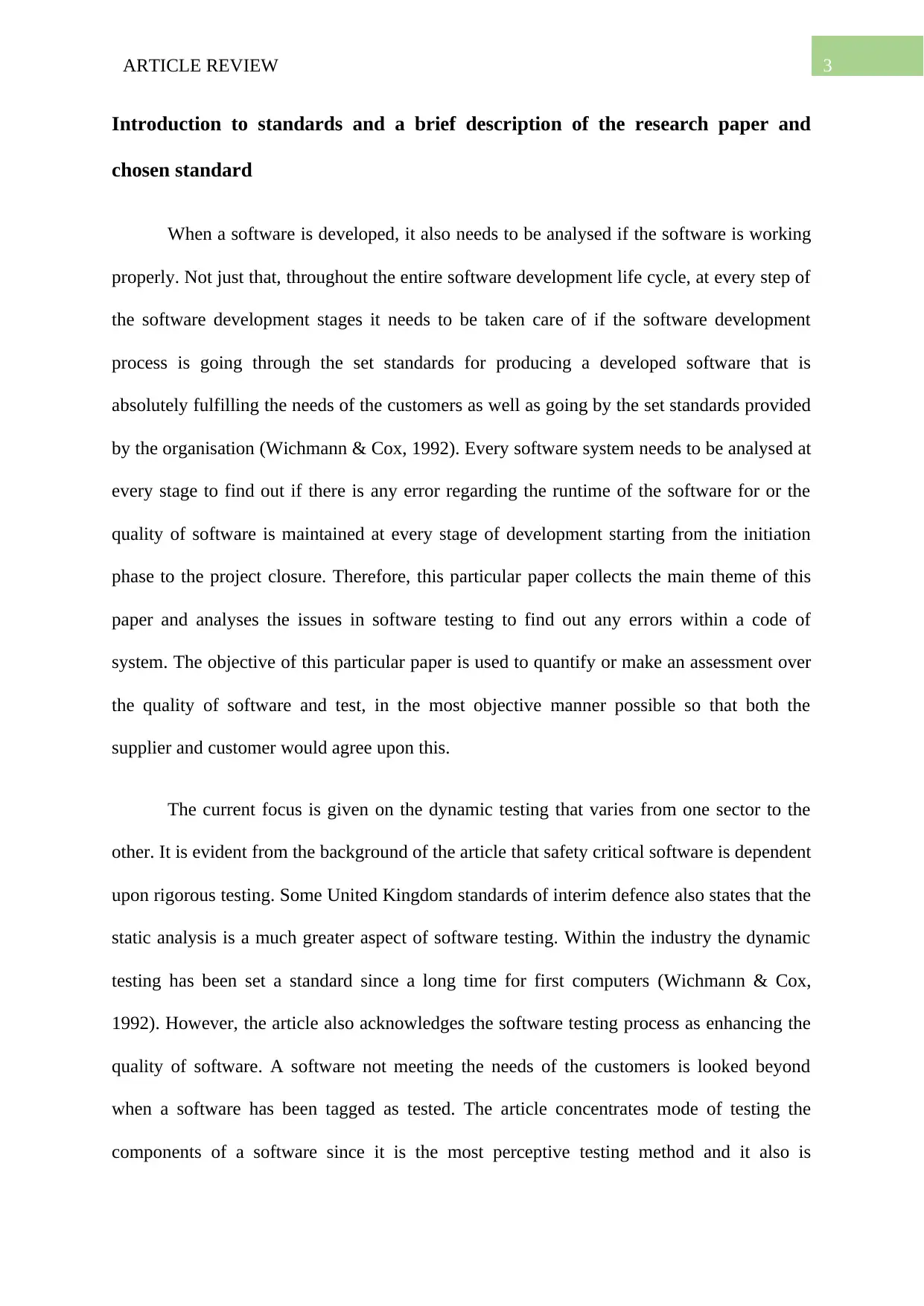
3ARTICLE REVIEW
Introduction to standards and a brief description of the research paper and
chosen standard
When a software is developed, it also needs to be analysed if the software is working
properly. Not just that, throughout the entire software development life cycle, at every step of
the software development stages it needs to be taken care of if the software development
process is going through the set standards for producing a developed software that is
absolutely fulfilling the needs of the customers as well as going by the set standards provided
by the organisation (Wichmann & Cox, 1992). Every software system needs to be analysed at
every stage to find out if there is any error regarding the runtime of the software for or the
quality of software is maintained at every stage of development starting from the initiation
phase to the project closure. Therefore, this particular paper collects the main theme of this
paper and analyses the issues in software testing to find out any errors within a code of
system. The objective of this particular paper is used to quantify or make an assessment over
the quality of software and test, in the most objective manner possible so that both the
supplier and customer would agree upon this.
The current focus is given on the dynamic testing that varies from one sector to the
other. It is evident from the background of the article that safety critical software is dependent
upon rigorous testing. Some United Kingdom standards of interim defence also states that the
static analysis is a much greater aspect of software testing. Within the industry the dynamic
testing has been set a standard since a long time for first computers (Wichmann & Cox,
1992). However, the article also acknowledges the software testing process as enhancing the
quality of software. A software not meeting the needs of the customers is looked beyond
when a software has been tagged as tested. The article concentrates mode of testing the
components of a software since it is the most perceptive testing method and it also is
Introduction to standards and a brief description of the research paper and
chosen standard
When a software is developed, it also needs to be analysed if the software is working
properly. Not just that, throughout the entire software development life cycle, at every step of
the software development stages it needs to be taken care of if the software development
process is going through the set standards for producing a developed software that is
absolutely fulfilling the needs of the customers as well as going by the set standards provided
by the organisation (Wichmann & Cox, 1992). Every software system needs to be analysed at
every stage to find out if there is any error regarding the runtime of the software for or the
quality of software is maintained at every stage of development starting from the initiation
phase to the project closure. Therefore, this particular paper collects the main theme of this
paper and analyses the issues in software testing to find out any errors within a code of
system. The objective of this particular paper is used to quantify or make an assessment over
the quality of software and test, in the most objective manner possible so that both the
supplier and customer would agree upon this.
The current focus is given on the dynamic testing that varies from one sector to the
other. It is evident from the background of the article that safety critical software is dependent
upon rigorous testing. Some United Kingdom standards of interim defence also states that the
static analysis is a much greater aspect of software testing. Within the industry the dynamic
testing has been set a standard since a long time for first computers (Wichmann & Cox,
1992). However, the article also acknowledges the software testing process as enhancing the
quality of software. A software not meeting the needs of the customers is looked beyond
when a software has been tagged as tested. The article concentrates mode of testing the
components of a software since it is the most perceptive testing method and it also is
Paraphrase This Document
Need a fresh take? Get an instant paraphrase of this document with our AI Paraphraser
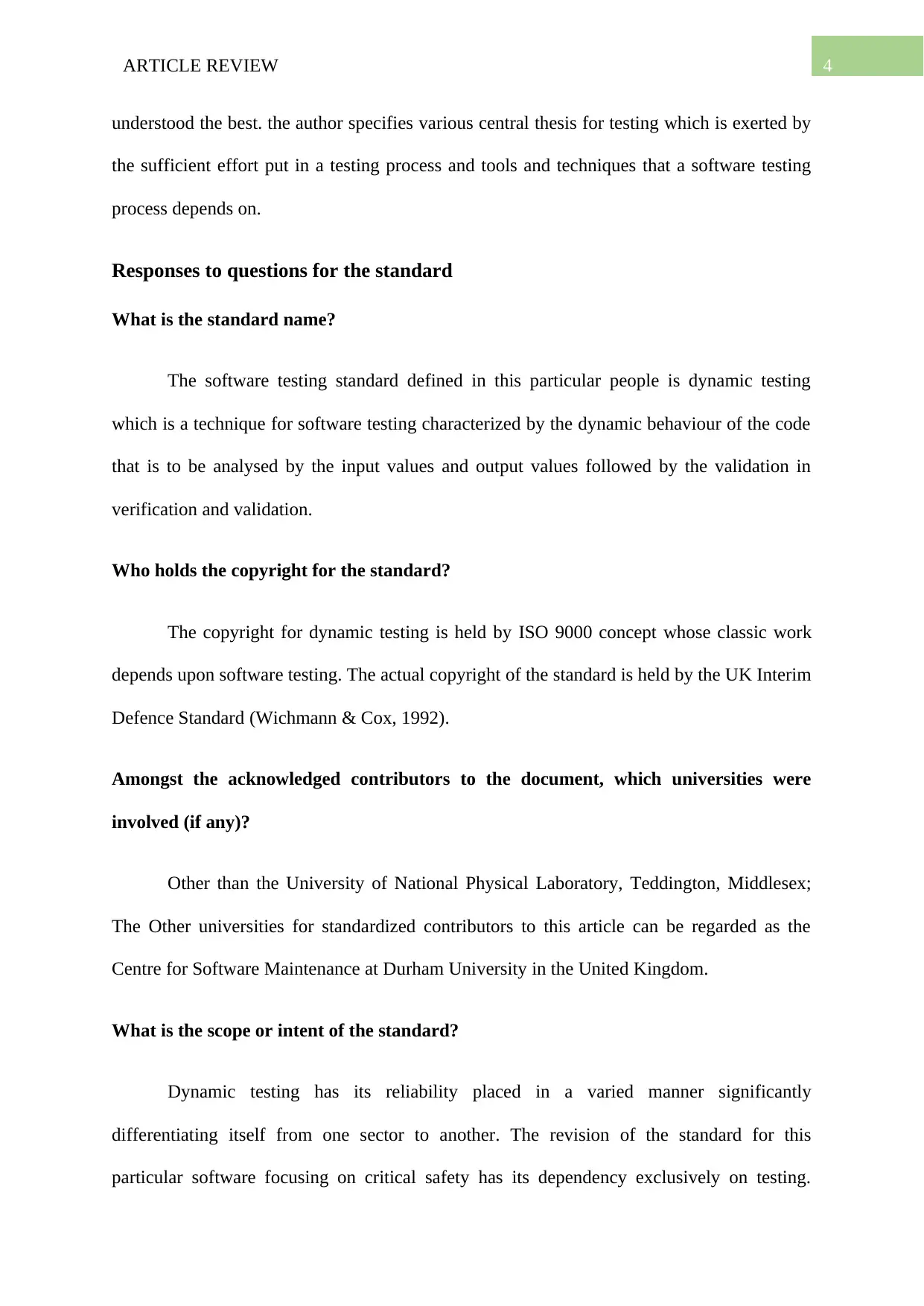
4ARTICLE REVIEW
understood the best. the author specifies various central thesis for testing which is exerted by
the sufficient effort put in a testing process and tools and techniques that a software testing
process depends on.
Responses to questions for the standard
What is the standard name?
The software testing standard defined in this particular people is dynamic testing
which is a technique for software testing characterized by the dynamic behaviour of the code
that is to be analysed by the input values and output values followed by the validation in
verification and validation.
Who holds the copyright for the standard?
The copyright for dynamic testing is held by ISO 9000 concept whose classic work
depends upon software testing. The actual copyright of the standard is held by the UK Interim
Defence Standard (Wichmann & Cox, 1992).
Amongst the acknowledged contributors to the document, which universities were
involved (if any)?
Other than the University of National Physical Laboratory, Teddington, Middlesex;
The Other universities for standardized contributors to this article can be regarded as the
Centre for Software Maintenance at Durham University in the United Kingdom.
What is the scope or intent of the standard?
Dynamic testing has its reliability placed in a varied manner significantly
differentiating itself from one sector to another. The revision of the standard for this
particular software focusing on critical safety has its dependency exclusively on testing.
understood the best. the author specifies various central thesis for testing which is exerted by
the sufficient effort put in a testing process and tools and techniques that a software testing
process depends on.
Responses to questions for the standard
What is the standard name?
The software testing standard defined in this particular people is dynamic testing
which is a technique for software testing characterized by the dynamic behaviour of the code
that is to be analysed by the input values and output values followed by the validation in
verification and validation.
Who holds the copyright for the standard?
The copyright for dynamic testing is held by ISO 9000 concept whose classic work
depends upon software testing. The actual copyright of the standard is held by the UK Interim
Defence Standard (Wichmann & Cox, 1992).
Amongst the acknowledged contributors to the document, which universities were
involved (if any)?
Other than the University of National Physical Laboratory, Teddington, Middlesex;
The Other universities for standardized contributors to this article can be regarded as the
Centre for Software Maintenance at Durham University in the United Kingdom.
What is the scope or intent of the standard?
Dynamic testing has its reliability placed in a varied manner significantly
differentiating itself from one sector to another. The revision of the standard for this
particular software focusing on critical safety has its dependency exclusively on testing.
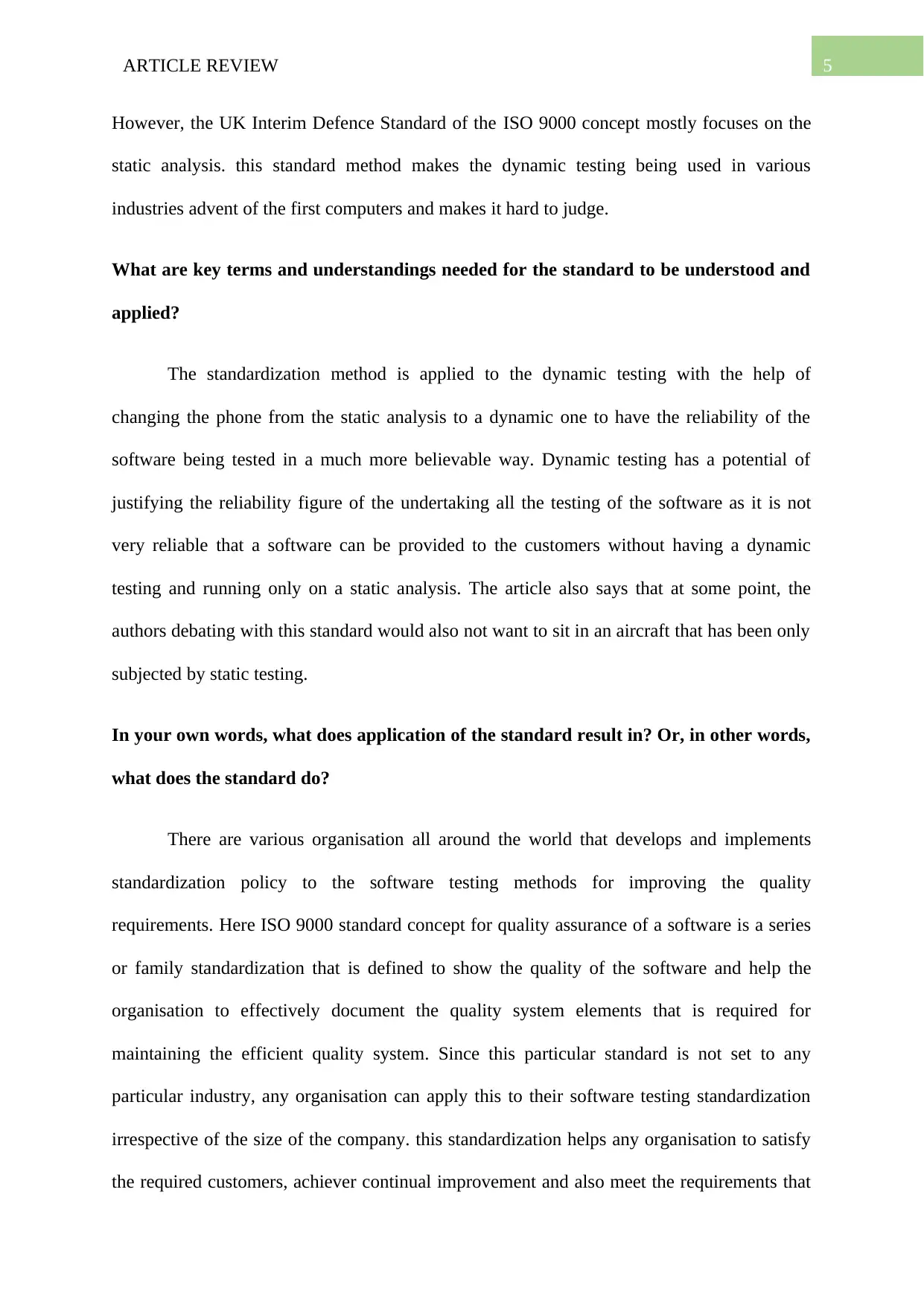
5ARTICLE REVIEW
However, the UK Interim Defence Standard of the ISO 9000 concept mostly focuses on the
static analysis. this standard method makes the dynamic testing being used in various
industries advent of the first computers and makes it hard to judge.
What are key terms and understandings needed for the standard to be understood and
applied?
The standardization method is applied to the dynamic testing with the help of
changing the phone from the static analysis to a dynamic one to have the reliability of the
software being tested in a much more believable way. Dynamic testing has a potential of
justifying the reliability figure of the undertaking all the testing of the software as it is not
very reliable that a software can be provided to the customers without having a dynamic
testing and running only on a static analysis. The article also says that at some point, the
authors debating with this standard would also not want to sit in an aircraft that has been only
subjected by static testing.
In your own words, what does application of the standard result in? Or, in other words,
what does the standard do?
There are various organisation all around the world that develops and implements
standardization policy to the software testing methods for improving the quality
requirements. Here ISO 9000 standard concept for quality assurance of a software is a series
or family standardization that is defined to show the quality of the software and help the
organisation to effectively document the quality system elements that is required for
maintaining the efficient quality system. Since this particular standard is not set to any
particular industry, any organisation can apply this to their software testing standardization
irrespective of the size of the company. this standardization helps any organisation to satisfy
the required customers, achiever continual improvement and also meet the requirements that
However, the UK Interim Defence Standard of the ISO 9000 concept mostly focuses on the
static analysis. this standard method makes the dynamic testing being used in various
industries advent of the first computers and makes it hard to judge.
What are key terms and understandings needed for the standard to be understood and
applied?
The standardization method is applied to the dynamic testing with the help of
changing the phone from the static analysis to a dynamic one to have the reliability of the
software being tested in a much more believable way. Dynamic testing has a potential of
justifying the reliability figure of the undertaking all the testing of the software as it is not
very reliable that a software can be provided to the customers without having a dynamic
testing and running only on a static analysis. The article also says that at some point, the
authors debating with this standard would also not want to sit in an aircraft that has been only
subjected by static testing.
In your own words, what does application of the standard result in? Or, in other words,
what does the standard do?
There are various organisation all around the world that develops and implements
standardization policy to the software testing methods for improving the quality
requirements. Here ISO 9000 standard concept for quality assurance of a software is a series
or family standardization that is defined to show the quality of the software and help the
organisation to effectively document the quality system elements that is required for
maintaining the efficient quality system. Since this particular standard is not set to any
particular industry, any organisation can apply this to their software testing standardization
irrespective of the size of the company. this standardization helps any organisation to satisfy
the required customers, achiever continual improvement and also meet the requirements that
⊘ This is a preview!⊘
Do you want full access?
Subscribe today to unlock all pages.

Trusted by 1+ million students worldwide
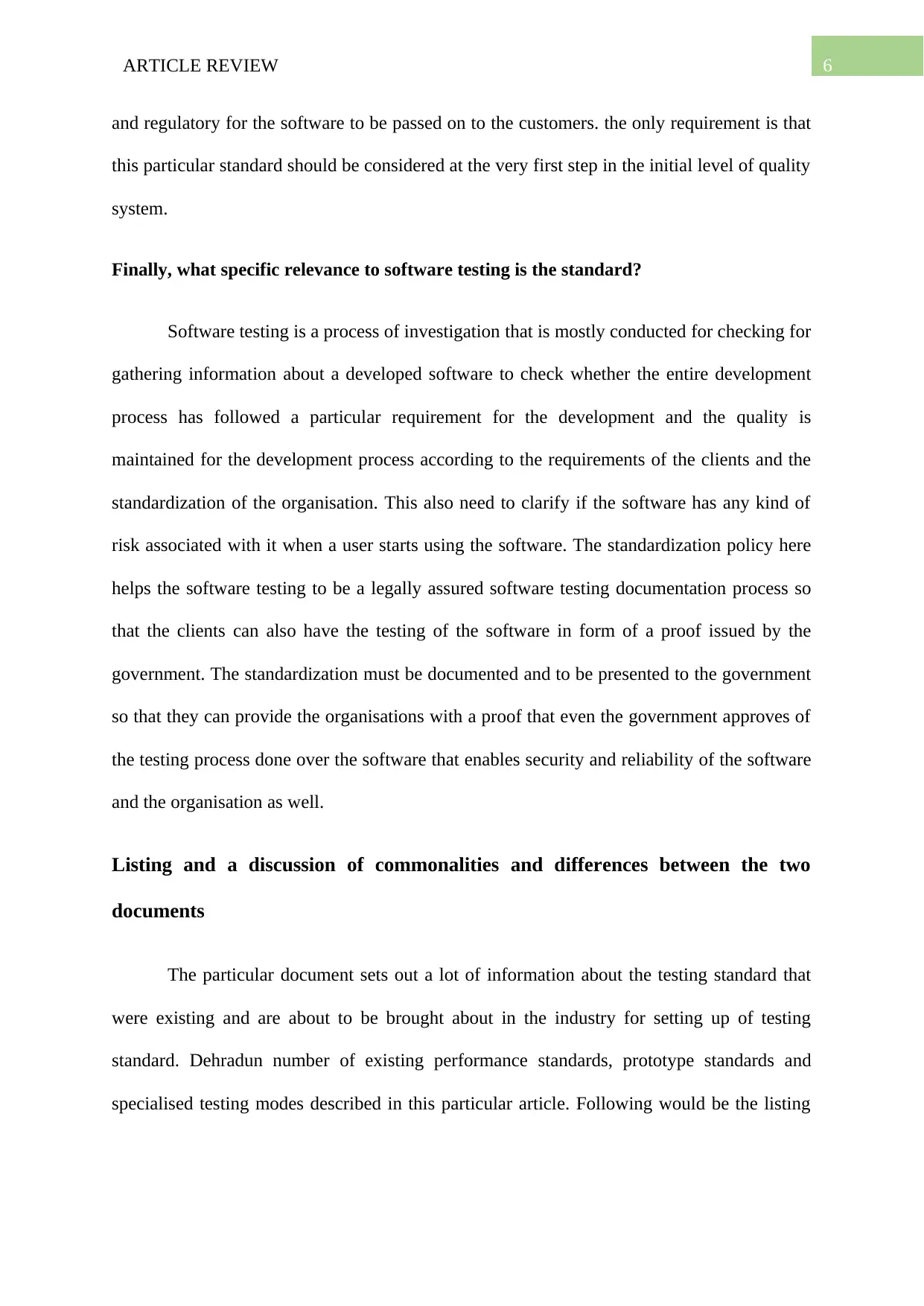
6ARTICLE REVIEW
and regulatory for the software to be passed on to the customers. the only requirement is that
this particular standard should be considered at the very first step in the initial level of quality
system.
Finally, what specific relevance to software testing is the standard?
Software testing is a process of investigation that is mostly conducted for checking for
gathering information about a developed software to check whether the entire development
process has followed a particular requirement for the development and the quality is
maintained for the development process according to the requirements of the clients and the
standardization of the organisation. This also need to clarify if the software has any kind of
risk associated with it when a user starts using the software. The standardization policy here
helps the software testing to be a legally assured software testing documentation process so
that the clients can also have the testing of the software in form of a proof issued by the
government. The standardization must be documented and to be presented to the government
so that they can provide the organisations with a proof that even the government approves of
the testing process done over the software that enables security and reliability of the software
and the organisation as well.
Listing and a discussion of commonalities and differences between the two
documents
The particular document sets out a lot of information about the testing standard that
were existing and are about to be brought about in the industry for setting up of testing
standard. Dehradun number of existing performance standards, prototype standards and
specialised testing modes described in this particular article. Following would be the listing
and regulatory for the software to be passed on to the customers. the only requirement is that
this particular standard should be considered at the very first step in the initial level of quality
system.
Finally, what specific relevance to software testing is the standard?
Software testing is a process of investigation that is mostly conducted for checking for
gathering information about a developed software to check whether the entire development
process has followed a particular requirement for the development and the quality is
maintained for the development process according to the requirements of the clients and the
standardization of the organisation. This also need to clarify if the software has any kind of
risk associated with it when a user starts using the software. The standardization policy here
helps the software testing to be a legally assured software testing documentation process so
that the clients can also have the testing of the software in form of a proof issued by the
government. The standardization must be documented and to be presented to the government
so that they can provide the organisations with a proof that even the government approves of
the testing process done over the software that enables security and reliability of the software
and the organisation as well.
Listing and a discussion of commonalities and differences between the two
documents
The particular document sets out a lot of information about the testing standard that
were existing and are about to be brought about in the industry for setting up of testing
standard. Dehradun number of existing performance standards, prototype standards and
specialised testing modes described in this particular article. Following would be the listing
Paraphrase This Document
Need a fresh take? Get an instant paraphrase of this document with our AI Paraphraser
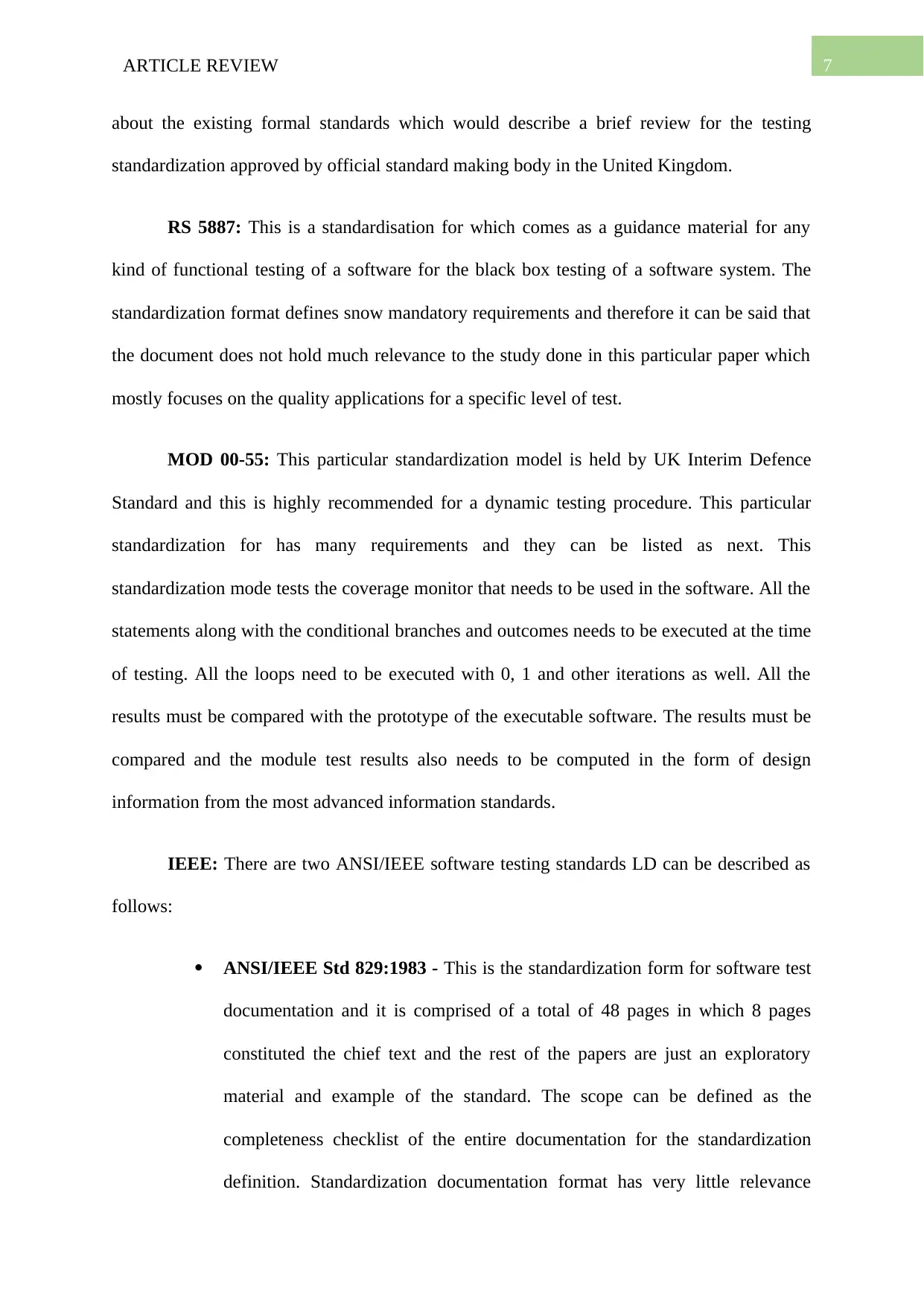
7ARTICLE REVIEW
about the existing formal standards which would describe a brief review for the testing
standardization approved by official standard making body in the United Kingdom.
RS 5887: This is a standardisation for which comes as a guidance material for any
kind of functional testing of a software for the black box testing of a software system. The
standardization format defines snow mandatory requirements and therefore it can be said that
the document does not hold much relevance to the study done in this particular paper which
mostly focuses on the quality applications for a specific level of test.
MOD 00-55: This particular standardization model is held by UK Interim Defence
Standard and this is highly recommended for a dynamic testing procedure. This particular
standardization for has many requirements and they can be listed as next. This
standardization mode tests the coverage monitor that needs to be used in the software. All the
statements along with the conditional branches and outcomes needs to be executed at the time
of testing. All the loops need to be executed with 0, 1 and other iterations as well. All the
results must be compared with the prototype of the executable software. The results must be
compared and the module test results also needs to be computed in the form of design
information from the most advanced information standards.
IEEE: There are two ANSI/IEEE software testing standards LD can be described as
follows:
ANSI/IEEE Std 829:1983 - This is the standardization form for software test
documentation and it is comprised of a total of 48 pages in which 8 pages
constituted the chief text and the rest of the papers are just an exploratory
material and example of the standard. The scope can be defined as the
completeness checklist of the entire documentation for the standardization
definition. Standardization documentation format has very little relevance
about the existing formal standards which would describe a brief review for the testing
standardization approved by official standard making body in the United Kingdom.
RS 5887: This is a standardisation for which comes as a guidance material for any
kind of functional testing of a software for the black box testing of a software system. The
standardization format defines snow mandatory requirements and therefore it can be said that
the document does not hold much relevance to the study done in this particular paper which
mostly focuses on the quality applications for a specific level of test.
MOD 00-55: This particular standardization model is held by UK Interim Defence
Standard and this is highly recommended for a dynamic testing procedure. This particular
standardization for has many requirements and they can be listed as next. This
standardization mode tests the coverage monitor that needs to be used in the software. All the
statements along with the conditional branches and outcomes needs to be executed at the time
of testing. All the loops need to be executed with 0, 1 and other iterations as well. All the
results must be compared with the prototype of the executable software. The results must be
compared and the module test results also needs to be computed in the form of design
information from the most advanced information standards.
IEEE: There are two ANSI/IEEE software testing standards LD can be described as
follows:
ANSI/IEEE Std 829:1983 - This is the standardization form for software test
documentation and it is comprised of a total of 48 pages in which 8 pages
constituted the chief text and the rest of the papers are just an exploratory
material and example of the standard. The scope can be defined as the
completeness checklist of the entire documentation for the standardization
definition. Standardization documentation format has very little relevance
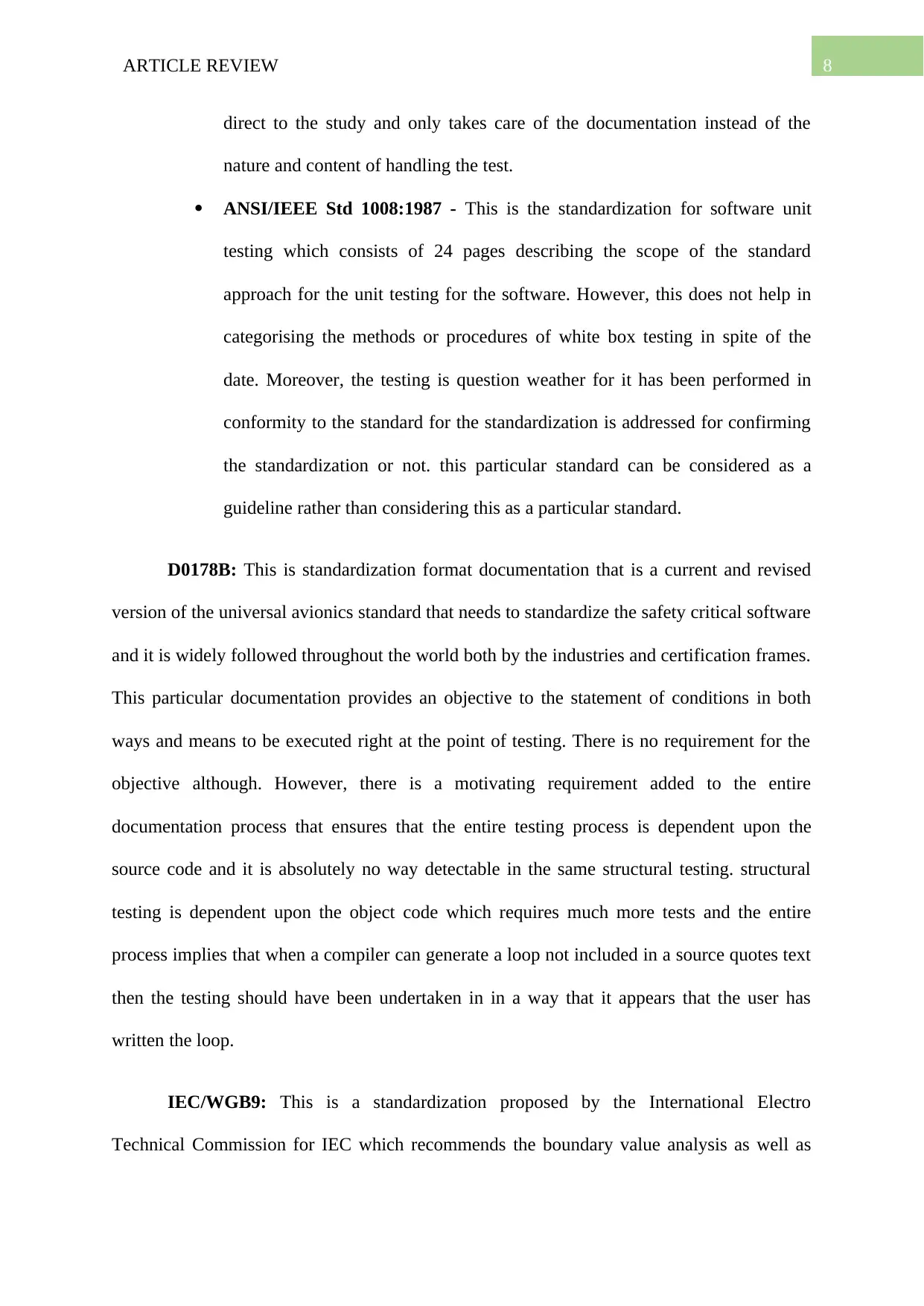
8ARTICLE REVIEW
direct to the study and only takes care of the documentation instead of the
nature and content of handling the test.
ANSI/IEEE Std 1008:1987 - This is the standardization for software unit
testing which consists of 24 pages describing the scope of the standard
approach for the unit testing for the software. However, this does not help in
categorising the methods or procedures of white box testing in spite of the
date. Moreover, the testing is question weather for it has been performed in
conformity to the standard for the standardization is addressed for confirming
the standardization or not. this particular standard can be considered as a
guideline rather than considering this as a particular standard.
D0178B: This is standardization format documentation that is a current and revised
version of the universal avionics standard that needs to standardize the safety critical software
and it is widely followed throughout the world both by the industries and certification frames.
This particular documentation provides an objective to the statement of conditions in both
ways and means to be executed right at the point of testing. There is no requirement for the
objective although. However, there is a motivating requirement added to the entire
documentation process that ensures that the entire testing process is dependent upon the
source code and it is absolutely no way detectable in the same structural testing. structural
testing is dependent upon the object code which requires much more tests and the entire
process implies that when a compiler can generate a loop not included in a source quotes text
then the testing should have been undertaken in in a way that it appears that the user has
written the loop.
IEC/WGB9: This is a standardization proposed by the International Electro
Technical Commission for IEC which recommends the boundary value analysis as well as
direct to the study and only takes care of the documentation instead of the
nature and content of handling the test.
ANSI/IEEE Std 1008:1987 - This is the standardization for software unit
testing which consists of 24 pages describing the scope of the standard
approach for the unit testing for the software. However, this does not help in
categorising the methods or procedures of white box testing in spite of the
date. Moreover, the testing is question weather for it has been performed in
conformity to the standard for the standardization is addressed for confirming
the standardization or not. this particular standard can be considered as a
guideline rather than considering this as a particular standard.
D0178B: This is standardization format documentation that is a current and revised
version of the universal avionics standard that needs to standardize the safety critical software
and it is widely followed throughout the world both by the industries and certification frames.
This particular documentation provides an objective to the statement of conditions in both
ways and means to be executed right at the point of testing. There is no requirement for the
objective although. However, there is a motivating requirement added to the entire
documentation process that ensures that the entire testing process is dependent upon the
source code and it is absolutely no way detectable in the same structural testing. structural
testing is dependent upon the object code which requires much more tests and the entire
process implies that when a compiler can generate a loop not included in a source quotes text
then the testing should have been undertaken in in a way that it appears that the user has
written the loop.
IEC/WGB9: This is a standardization proposed by the International Electro
Technical Commission for IEC which recommends the boundary value analysis as well as
⊘ This is a preview!⊘
Do you want full access?
Subscribe today to unlock all pages.

Trusted by 1+ million students worldwide
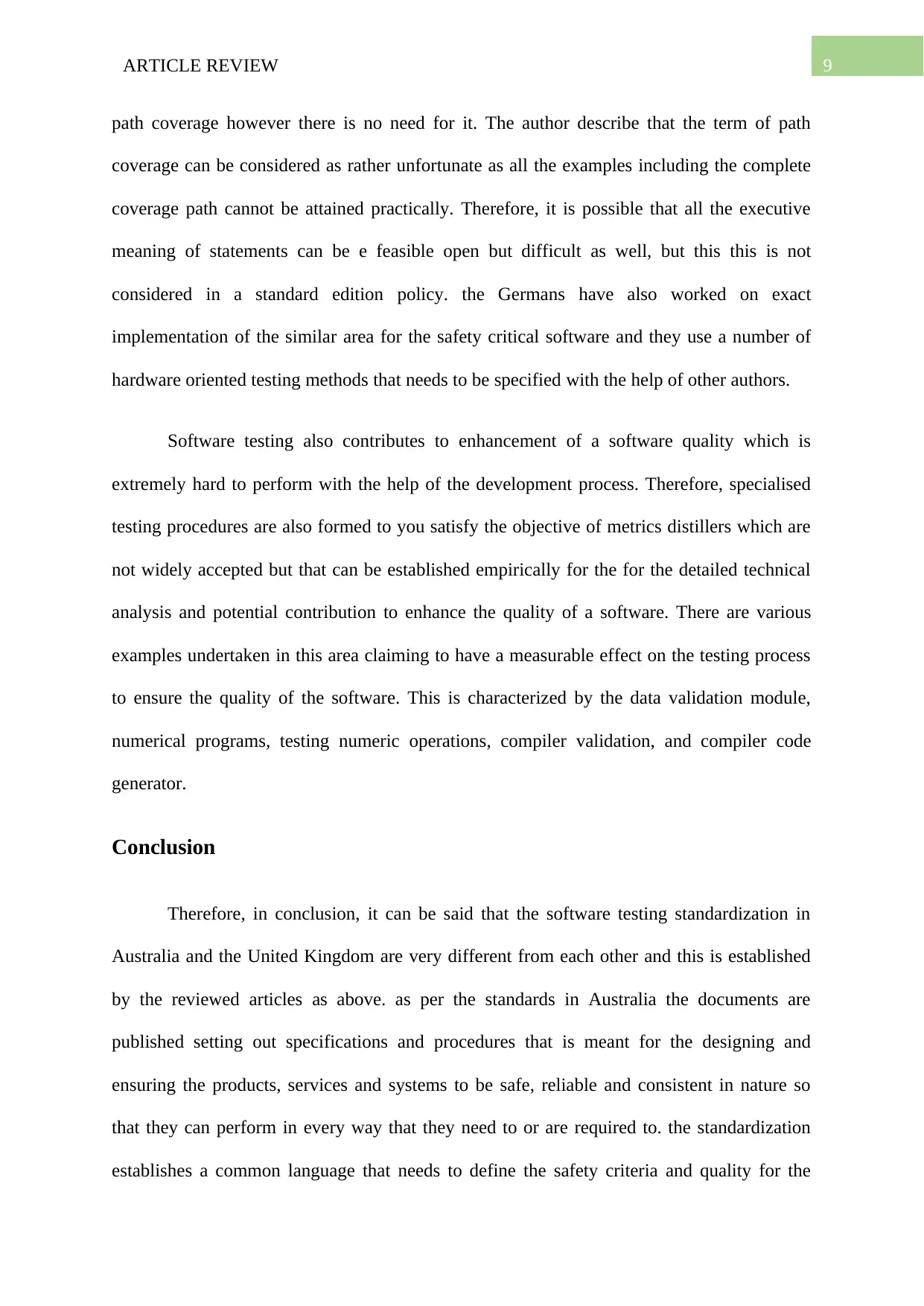
9ARTICLE REVIEW
path coverage however there is no need for it. The author describe that the term of path
coverage can be considered as rather unfortunate as all the examples including the complete
coverage path cannot be attained practically. Therefore, it is possible that all the executive
meaning of statements can be e feasible open but difficult as well, but this this is not
considered in a standard edition policy. the Germans have also worked on exact
implementation of the similar area for the safety critical software and they use a number of
hardware oriented testing methods that needs to be specified with the help of other authors.
Software testing also contributes to enhancement of a software quality which is
extremely hard to perform with the help of the development process. Therefore, specialised
testing procedures are also formed to you satisfy the objective of metrics distillers which are
not widely accepted but that can be established empirically for the for the detailed technical
analysis and potential contribution to enhance the quality of a software. There are various
examples undertaken in this area claiming to have a measurable effect on the testing process
to ensure the quality of the software. This is characterized by the data validation module,
numerical programs, testing numeric operations, compiler validation, and compiler code
generator.
Conclusion
Therefore, in conclusion, it can be said that the software testing standardization in
Australia and the United Kingdom are very different from each other and this is established
by the reviewed articles as above. as per the standards in Australia the documents are
published setting out specifications and procedures that is meant for the designing and
ensuring the products, services and systems to be safe, reliable and consistent in nature so
that they can perform in every way that they need to or are required to. the standardization
establishes a common language that needs to define the safety criteria and quality for the
path coverage however there is no need for it. The author describe that the term of path
coverage can be considered as rather unfortunate as all the examples including the complete
coverage path cannot be attained practically. Therefore, it is possible that all the executive
meaning of statements can be e feasible open but difficult as well, but this this is not
considered in a standard edition policy. the Germans have also worked on exact
implementation of the similar area for the safety critical software and they use a number of
hardware oriented testing methods that needs to be specified with the help of other authors.
Software testing also contributes to enhancement of a software quality which is
extremely hard to perform with the help of the development process. Therefore, specialised
testing procedures are also formed to you satisfy the objective of metrics distillers which are
not widely accepted but that can be established empirically for the for the detailed technical
analysis and potential contribution to enhance the quality of a software. There are various
examples undertaken in this area claiming to have a measurable effect on the testing process
to ensure the quality of the software. This is characterized by the data validation module,
numerical programs, testing numeric operations, compiler validation, and compiler code
generator.
Conclusion
Therefore, in conclusion, it can be said that the software testing standardization in
Australia and the United Kingdom are very different from each other and this is established
by the reviewed articles as above. as per the standards in Australia the documents are
published setting out specifications and procedures that is meant for the designing and
ensuring the products, services and systems to be safe, reliable and consistent in nature so
that they can perform in every way that they need to or are required to. the standardization
establishes a common language that needs to define the safety criteria and quality for the
Paraphrase This Document
Need a fresh take? Get an instant paraphrase of this document with our AI Paraphraser
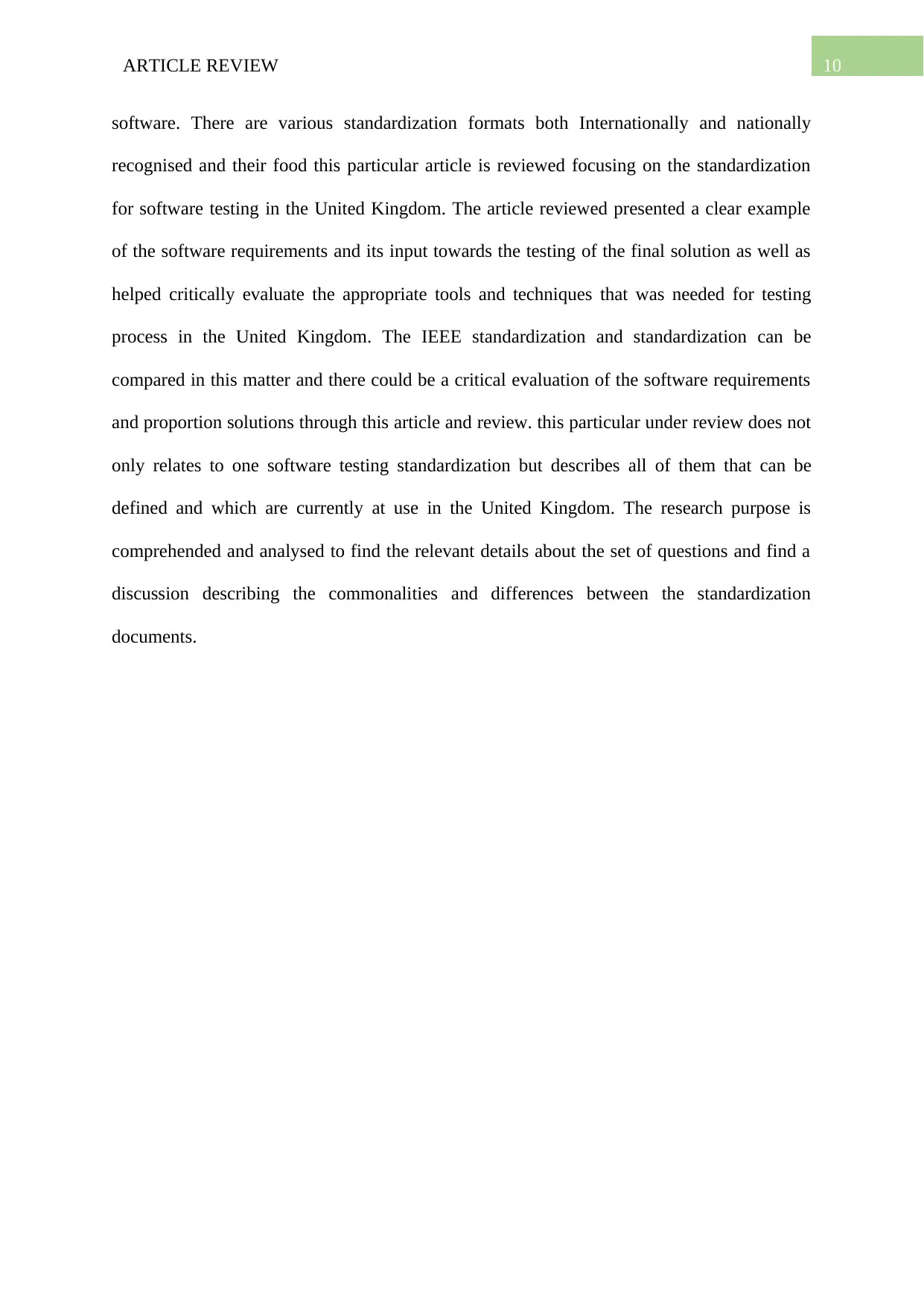
10ARTICLE REVIEW
software. There are various standardization formats both Internationally and nationally
recognised and their food this particular article is reviewed focusing on the standardization
for software testing in the United Kingdom. The article reviewed presented a clear example
of the software requirements and its input towards the testing of the final solution as well as
helped critically evaluate the appropriate tools and techniques that was needed for testing
process in the United Kingdom. The IEEE standardization and standardization can be
compared in this matter and there could be a critical evaluation of the software requirements
and proportion solutions through this article and review. this particular under review does not
only relates to one software testing standardization but describes all of them that can be
defined and which are currently at use in the United Kingdom. The research purpose is
comprehended and analysed to find the relevant details about the set of questions and find a
discussion describing the commonalities and differences between the standardization
documents.
software. There are various standardization formats both Internationally and nationally
recognised and their food this particular article is reviewed focusing on the standardization
for software testing in the United Kingdom. The article reviewed presented a clear example
of the software requirements and its input towards the testing of the final solution as well as
helped critically evaluate the appropriate tools and techniques that was needed for testing
process in the United Kingdom. The IEEE standardization and standardization can be
compared in this matter and there could be a critical evaluation of the software requirements
and proportion solutions through this article and review. this particular under review does not
only relates to one software testing standardization but describes all of them that can be
defined and which are currently at use in the United Kingdom. The research purpose is
comprehended and analysed to find the relevant details about the set of questions and find a
discussion describing the commonalities and differences between the standardization
documents.
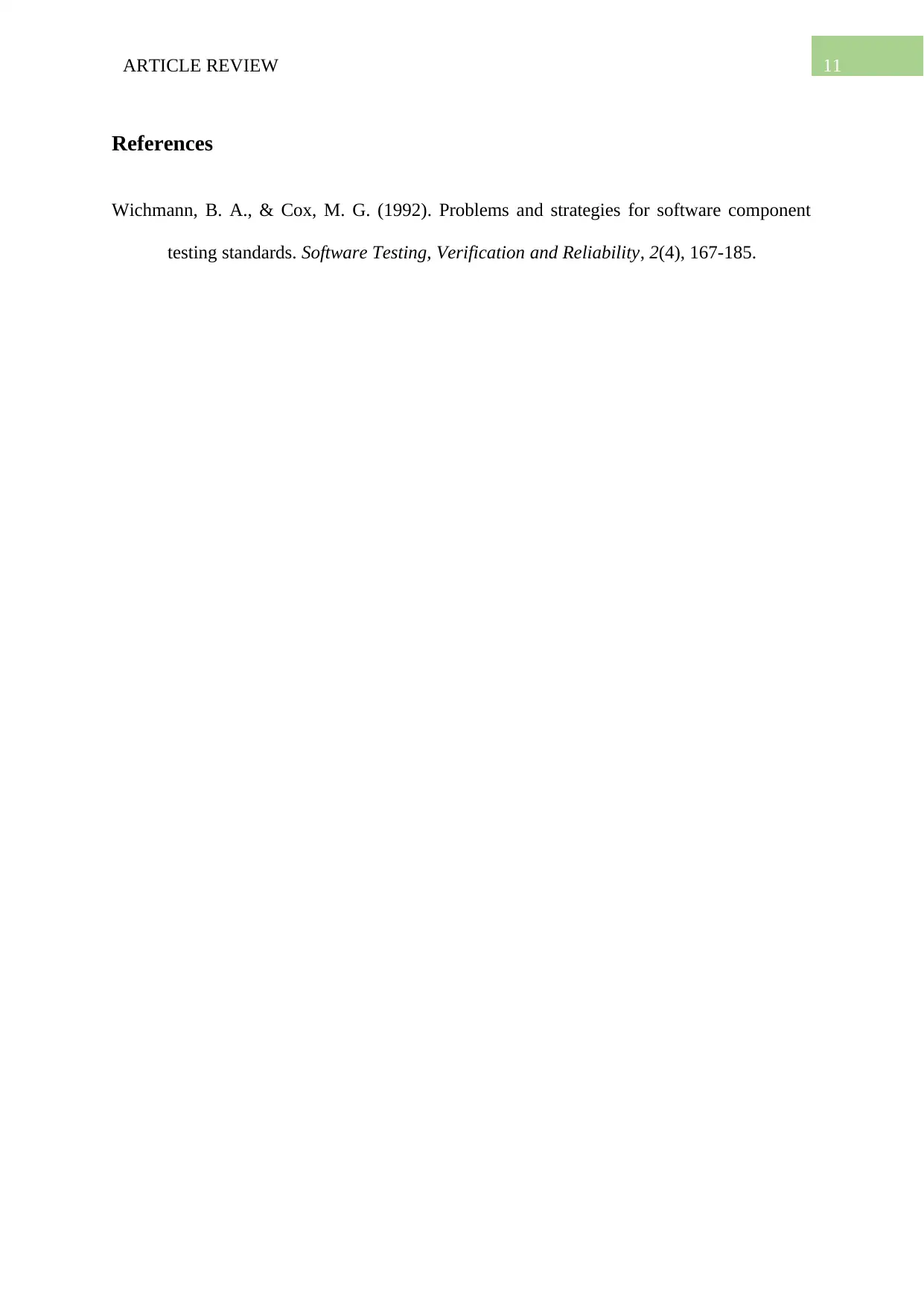
11ARTICLE REVIEW
References
Wichmann, B. A., & Cox, M. G. (1992). Problems and strategies for software component
testing standards. Software Testing, Verification and Reliability, 2(4), 167-185.
References
Wichmann, B. A., & Cox, M. G. (1992). Problems and strategies for software component
testing standards. Software Testing, Verification and Reliability, 2(4), 167-185.
⊘ This is a preview!⊘
Do you want full access?
Subscribe today to unlock all pages.

Trusted by 1+ million students worldwide
1 out of 12
Related Documents
Your All-in-One AI-Powered Toolkit for Academic Success.
+13062052269
info@desklib.com
Available 24*7 on WhatsApp / Email
![[object Object]](/_next/static/media/star-bottom.7253800d.svg)
Unlock your academic potential
Copyright © 2020–2025 A2Z Services. All Rights Reserved. Developed and managed by ZUCOL.





